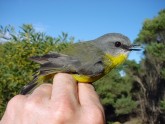Why birds that live where people live?
Worldwide, many bird species are in decline. In 2000, 1:5 (20%) of Australian bird species were threatened with extinction. This is being caused by a number of factors, primarily the loss and fragmentation of suitable places for them to live (habitat) but also factors such as pollution and the continuing use of insecticides. These declines are likely to increase with the rapid-onset of extreme changes in climate that are predicted and are already beginning to occur, and as Australia’s population increases and forces the continued expansion of the areas that we use and live in.
No doubt, the protection of our natural environment and the wildlife within it should be our number 1 priority but the value of the urban environment to birdlife cannot be underestimated. The process of urbanisation typically results in a landscape vastly different from the original, with the original vegetation often surviving only in small pockets scattered throughout the city. As bird species abandon built-up or developed areas through loss of suitable habitat, the people who move in and live there are often unaware of what lived there before them but have now been lost. It is unsurprising that, given the dramatic impact that urbanisation has on the natural environment, some birds simply cannot make the transition into urban areas. However, urban environments are not totally devoid of vegetation—remnant patches, parks and suburban gardens all form suitable habitat for a range of native bird species.
The bird communities in our urban and regional centres have undergone change in the last 40 years with a loss of small birds (such as Superb Fairy-wrens and Eastern Spinebills) corresponding with an increase in larger, more aggressive native and introduced species (such as the Noisy Miner, Pied Currawong and Common Myna). With our changing gardening styles, loss of natural habitat and climate change amongst a range of pressures facing our native birds, we are at serious risk of loosing a great many of these species that we derive such joy from. People everywhere are losing the experience of having a variety of birds living near them and birds are losing suitable places to live so their numbers are declining.
Until comparatively recently, little research had been done to determine the status of birds that live where people live; to identify the specific causes of their declines, to determine how to halt them so that people and birds can live together. There were few methods or tools being suggested to help change the situation.
The Birds in Backyards program was developed specifically to address the loss of small birds from our parks and gardens by providing tools that people can use to:
- learn about birds and the natural environment in their areas and
- to help them make changes to accommodate birds
The Birds in Backyards Program also has a wider agenda. It is hoped that as people engage with birds and their needs, they will also gain a greater understanding for the need to maintain biodiversity in all its complexity. Birds are known to be extremely good indicators of the health of the environment so learning about birds provides opportunities for people to learn about the natural world and how it works in a broad and practical way.











